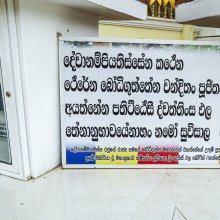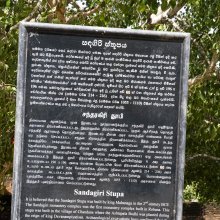Devanampiyatissa, Devānampiyatissa, Devanampiya-tissa: 1 definition
Introduction:
Devanampiyatissa means something in Buddhism, Pali. If you want to know the exact meaning, history, etymology or English translation of this term then check out the descriptions on this page. Add your comment or reference to a book if you want to contribute to this summary article.
Images (photo gallery)
In Buddhism
Theravada (major branch of Buddhism)
Source: Pali Kanon: Pali Proper NamesKing of Ceylon (247-207 B.C.). He was the second son of Mutasiva. It is said that on the day of his coronation many wonderful treasures miraculously appeared, some of which he resolved to send as tokens of esteem to his contemporary Dhammasoka of India, with whom he had long been on terms of friendship. An embassy, led by his nephew Maharittha, was despatched to Pataliputta, and the emperor showed the ambassadors every mark of honour. He sent back with them all the requisites for a coronation, with instructions to celebrate the inauguration of the Sinhalese king, whom he invited to embrace Buddhism. On the return of the embassy, the king was solemnly crowned a second time. This confirmation of Devanampiyatissas sovereignty under the aegis of Asoka may have been due either to the commanding position of Asoka or for the strengthening of family connections. Asoka was a Moriyan (a branch of the Sakiyans) and Devanampiyatissa had Sakiyan blood.
The chief event in the reign of Devanampiyatissa was the arrival of Mahinda in Ceylon. He arrived at the head of a mission in the year of the kings second coronation. Mahinda met the king hunting on the full moon day of Jettha. The king welcomed him with great honour and speedily embraced the new religion, to which Asoka had already drawn his attention.
His conversion was the direct result of Mahindas preaching of the Culahatthipadopama Sutta. His earlier religion is not known, it may have been Jainism. His example was followed by a large number of his subjects, many of whom entered the Order. Devanampiyatissa dedicated to their use the Nandana park and the Mahameghavana, which he himself had laid out a little earlier. In the Mahameghavana he built the famous Maha Vihara which, for many centuries, remained the centre of the orthodox religion in Ceylon. The dedication of the Maha Vihara took place in the two hundred and thirty sixth year after the death of the Buddha. The kings next pious work was the erection of the Cetiyapabbata vihara and he, later, built the Thuparama, containing the Buddhas right collar bone.
When the women of the palace, led by Anula, wife of the sub king, Mahanaga, expressed a desire to become nuns, Devanampiyatissa sent another embassy to Asoka asking him to send Sanghamitta, together with the right branch of the sacred Bodhi tree. This branch miraculously severed itself from the parent tree and, together with Sanghamitta, was conveyed down the Ganges and arrived in Jambukola, where it was received with all honour by Devanampiyatissa. From Jambukola it was taken in procession to Anuradhapura, where it was planted in the Mahameghavana, the king instituting in its honour a festival, which was observed for many centuries. For the use of Sanghamitta and the nuns the king erected various buildings,
Theravāda is a major branch of Buddhism having the the Pali canon (tipitaka) as their canonical literature, which includes the vinaya-pitaka (monastic rules), the sutta-pitaka (Buddhist sermons) and the abhidhamma-pitaka (philosophy and psychology).
See also (Relevant definitions)
Partial matches: Tissa.
Full-text (+60): Mahinda, Kammaradeva, Kantaka Cetiya, Maruppiya, Mahasena, Tela, Uddhakandaraka, Parantapabbata, Uddhaculabhaya, Nivattacetiya, Sunhata-parivena, Phalagga Parivena, Hemasa, Dola, Gajakumbhakapasana, Suma, Kunjara, Puttatissa, Somanassamalaka, Gangalatittha.
Relevant text
Search found 8 books and stories containing Devanampiyatissa, Devanampiya-tissa, Devānampiya-tissa, Devānampiyatissa; (plurals include: Devanampiyatissas, tissas, Devānampiyatissas). You can also click to the full overview containing English textual excerpts. Below are direct links for the most relevant articles:
A Short history of Lanka (by Humphry William Codrington)
Dipavamsa (study) (by Sibani Barman)
Mahavamsa (by Wilhelm Geiger)
Chapter 19 - The Coming Of The Bodhi-tree
Chapter 11 - The Consecrating Of Devanampiyatissa
A Glimpse into Sinhalese Poetry < [May, 1928]
Visuddhimagga (the pah of purification) (by Ñāṇamoli Bhikkhu)
Background and Main Facts < [Introduction]
The Buddha and His Teachings (by Narada Thera)

